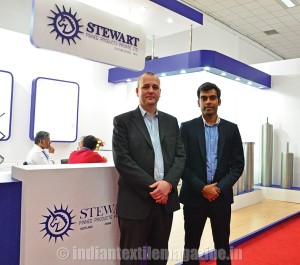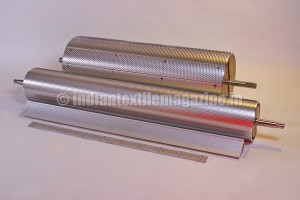Stewart Pinned Products Ltd. of the UK, a global leader in the manufacture of components for textile machinery, has recently set up a manufacturing plant in Bangalore to cater to the Indian market. Started in 2013, the Indian entity, Stewart Pinned Products Private Ltd., is a full production facility owned and operated by Stewart Pinned Products in Scotland. We spoke to Mr. Mohammed Haris, Director of Indian operations on the company’s business in India.

How was the overall response at Texfair 2015?
We had a great response. Our aim to reach various categories of customers within south India was achieved. We showcased a range of products which received a good response and had a good number of enquiries. We are hoping for a great year ahead. The show was well organised, and I should really thank the SIMA team for the same. We hope to come back next year as well.
Can you provide details of the new products launched at the show?
We launched two products – Pinlocked Stationary Fixed Flats and Spiked Lattice, at the show.
Our innovative Pinlocked Stationary Carding Flats is the latest development from Stewart Pinned products. In this product we incorporate Stewart Pinlock system with pins over the outdated traditional wire flats. We have a range of pin densities up to maximum of 600 points per square inch. Our Sales engineers would be able to suggest based on the fine counts and usage depending on the requirements of mills and their outputs.
A number of experiments concluded that Pinlocked Stationary Fixed Flats has an outstanding life of about 4 times than the traditional wire flats. The hardened carbon steel pins results in excellent fibre penetration and reduces fibre rupture, less maintenance for mills and enhanced output. All in makes a good replacement for the wire flats.
We introduced Spiked Lattice for the Indian market at the Texfair show. It’s a new one from our production house in India. Although a traditional concept, it has been designed with better engineering to meet the expectations of high production of the latest generation blowroom machines.
How was the year 2014 for Stewart globally and in India?
Globally, overall, it was a successful year for our offices in Scotland, China, Latin America and India. We are pioneers as far the global market is concerned. Our parent company in Scotland and other unit in China have met all the OEM requirements worldwide.The constraint for the Indian market in importing the pinned products has been eased out by setting up our plant in India in 2013 in Bangalore and allowing us to easily penetrate and keep selling at a competitive rate.
In India, 2013-14 was a good year for us. However, the third quarter was quite affected with bad market condition. With respect to our internal growth, I think we need to go a long way. We started off a year-and-half ago, and today we can cater a wide range of products and can fully manufacture new products at our Bangalore facility. We have also started refurbishments a few months ago and have now started promoting mills to periodically service their pinned products. We are educating the customers about the quality of fibre improvement they can expect in keeping their textile parts, rollers and other pinned products conditioned.
What are your expectations in 2015 in terms of overall industry growth and growth for your company?
We feel there is an upward trend. Last year alone the textile exports has increased by 15 per cent depicting a huge consumption. We expect to grow along with the same trend. A weaker rupee and good demand for garments and yarn in the coming year will certainly see good growth. Indian market sounds very promising too. We are focussing our attentions to small and medium scale machine manufacturers who could use our products to enhance their machine output.
Our aim for 2015-16 is to penetrate further deep into the markets across the country. Specifically in the North there are a lot of developments under the leadership of Prime Minister Modi. I am sure we can capitalise on that.
How is the Indian manufacturing facility shaping up? What is the manufacturing capacity, and have you been able to cater to the demand in the Indian domestic market both with the machinery manufacturers and end customers?
It’s a fully functioning facility. It’s completed its full one year cycle and now stands with a capacity to manufacture all range of products required for Indian market. We have a line of high precision machines that helps us to keep our quality level high. Constant work force training and changes to suit customer demands are met. We work strictly on high quality raw materials for all our products by working with top notch suppliers.
We are looking to invest in some new machines and recruit more staff in 2015-16. Our Sales team are constantly adding new end customers and have added up 60 new end customers in our list within a span of one year.
What are your future plans for the Indian market? Do you see India as an important growth market for the future?
India is a great market. It’s always booming year after year. We are setting up sales in the North and are making special efforts to support small and medium-scale machine manufactures to grow. We do have our marketing plans laid down for next year, and it is looking quite busy with a few key participation in international and domestic exhibitions.
The year 2015 will be a more efficiency and innovation-driven market for India. We are here to stay, and we enjoy healthy competition in the Indian market. We forecast a huge potential for growth in the local market.
